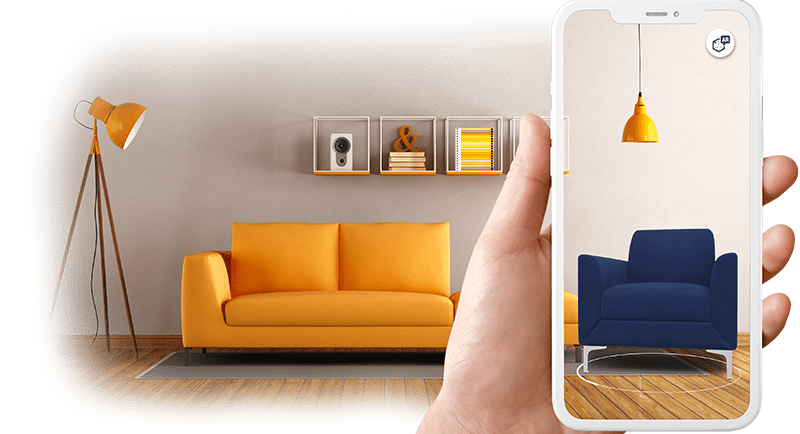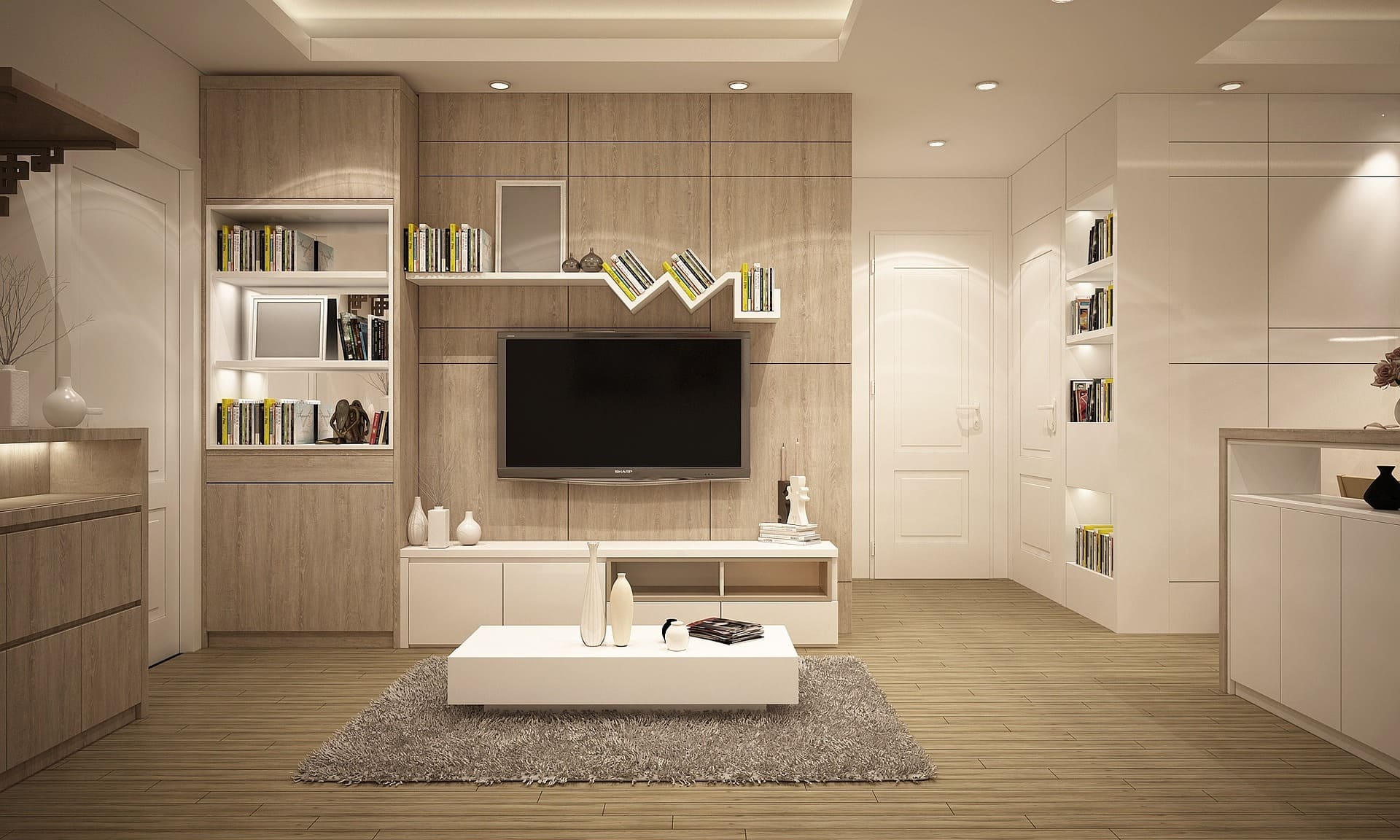The wise say, “A picture is worth a thousand words.”
But there’s no guarantee that furniture will look good in your living room or that the refrigerator will properly fit in your kitchen.
Most online retail marketplaces are built on static images. While these images can be stunning and catchy to the eye, they lack tactile perception – a reality that makes you see and experience a product as if you were physically present. Enter the world of Augmented Reality furniture.
3D and Augmented Reality technologies allow furniture brands to provide their customers with a try-before-you-buy shopping experience with realistic product visualization that drives sales.
The use of Augmented Reality in furniture stores has gained traction over the past few years. A recent study conducted by Centric Digital found that 60% of shoppers want to use augmented reality as part of their furniture shopping experience.
But how can brands drive sales with AR? We’ll delve into the crux of 3D and AR in furniture stores and explain how these technologies can be used to drive engagement and sales. We’ll also walk you through the steps to implementing AR in your furniture store.
The Rise of Augmented Reality (AR) in Online Shopping
Augmented reality (AR) is an emerging technology that has truly revolutionized the way we shop, communicate, and even play games.
Despite being around since 1968 – when the first AR headset was developed by scientists at Harvard University, AR only gained significant traction with the success of Pokémon Go. The game uses AR to make Pokémon appear anchored to the real-world right in front of you.
The onset of COVID-19 further changed the game for AR and VR, as online shopping stole the spotlight. Research shows that global spending on AR and VR headsets grew 50% in 2020 to reach a staggering $12 billion.
Today, customers are less hesitant and widely use augmented reality to facilitate shopping. Used in shopping, AR gives consumers the power to change some elements of their surroundings without changing them.
For instance, AR allows consumers to try out furniture virtually. Shoppers can stage the furniture and experience how it would appear in their rooms. Most importantly, it helps shoppers determine whether the furniture would fit their room or not.
In the realm of e-commerce, furniture businesses should harness the power of 3D & AR to distinguish themselves from competitors.
How to Drive Online Sales with 3D & Augmented Reality for Furniture
Thanks to technologies like AR and 3D rendering, the furniture industry is having its online moment. Here are some stats to enumerate the impact of AR on furniture sales:
- Retailers using augmented reality see a 20% increase in customer engagement, with 90% higher conversions than services not using AR;
- Product pages with 3D and AR experience higher value sales, with 21% higher revenue per visit and 13% higher average order size;
- Customers are 11 times more likely to buy from a brand that uses 3D and AR tools
These stats should give insights into how the application of AI can help boost your furniture sales online. But how exactly are 3D visualization and AR pushing online furniture sales?
1. AR Enables Customers to Virtually “Try” Out Furniture
One of the big challenges when buying furniture is trying to visualize what it will look like in your home. While returning a dress that doesn’t fit is a straightforward process, sending back a bulky item, like a furniture set, can present a lot of challenges.
And this is where AR comes in. Leveraging the 3D and AR technologies allows you to bring the in-store experience to online shopping and see furniture in your room from your screen.
With 3D modeling, retailers can use interactive, graphical representations of their furniture items. Customers can rotate the object, zoom in or out, and even view it in motion right from their mobile app or browser. This gives them a greater understanding of the features and functionalities of the product while envisioning what it looks like in real life.
In a nutshell, the use of 3D And Augmented Reality furniture allows customers to:
- View the product from different sides;
- Move the object around the room;
- Determine whether an object will fit in their room without using a tape measure;
- Play around with different colors, patterns, and styles;
- Envision what the room will look like with the new furniture;
- Get 360 product views in seconds.
With these immersive capabilities, augmented reality and 3D renderings increase the customer satisfaction level, leading to more sales and fewer returns. These technologies also help to eliminate the guesswork out of the furniture shopping experience.
2. Customers Can Determine the Size of Furniture Before Buying
Nothing can be more frustrating than buying a piece of furniture, only to realize later that it can’t fit its designated space.
Augmented Reality furniture apps help to avoid this problem by allowing customers to determine the size of the furniture right within their desktop or mobile app. Through AR and 3D rendering, your smartphone becomes your measuring device.
As you start to encode the product in a 3D environment, you also capture the measurements of those products. As such, your phone doubles as a measuring device, allowing you to measure dimensions and only settle with products that are the right fit for your house.

3. AR Imparts that Emotional Experience That Static Images Can’t Provide
The number one driving force behind most purchases is emotions.
Connecting emotionally with a product increases your likelihood of buying it. And that’s where AR outshines the conventional means of advertising.
Interacting with a product in a virtual space builds up emotions that connect consumers to products they’re viewing, making them want to experience similar emotions in the future. AR creates more positive feelings about a product.
By providing an unparalleled shopping experience with AR, furniture retailers increase the likelihood that consumers will want to create those experiences.
4. AR Increases Buyer Confidence
Consumers trust their emotions and logic when buying products.
They weigh the product’s pros and cons, give clues about their emotions, and decide on the items that make the most sense to them.
Without technology that elicits the actual perception of the product, it can be hard to impart emotions and clues that will make customers trust your products. AR’s visualization capabilities help consumers eliminate doubt about a product they intend to buy.
As mentioned, AR elicits feelings that help build a connection with a product. This increases buyer confidence as shoppers are more likely to purchase items they have built a connection with, which ultimately increases the likelihood of a sale.
Get Started With Augmented Reality Furniture Visualizer
Now that you know the impact of AR on sales and how it helps to drive furniture sales, how do you implement AR for furniture in your e-commerce store? Simply follow the steps outlined below.
Step 1: Grab Your 3D Models
The first step is pretty much straightforward. You need to have 3D models of the furniture or any other product you offer.
It’s likely you have those models in place, and you have shared them with your architects or product designers. Based on these models, you’ll be able to generate high-quality AR product descriptions to use within your mobile or desktop app.
Step 2: Choose Your Tech
Big companies, like Ikea, invest heavily in their own AR applications. However, many companies use WebAR – a technology that allows users to access augmented reality experiences directly from their smartphones.
With the right tools, you can make your products available in WebAR in 30 minutes without worrying about integrations.
Step 3: Generate AR Content
If you choose to build your own AR app, you’ll have to contend with the pain of designing a new UI, figuring out how to integrate the app within your sales processes, etc.
However, if you opt for WebAR, you can jump straight to the fun part – content creation.
You simply need to upload your 3D models, choose the colors and texture, and watch your 3D models/files turn into lifelike AR experiences.
Step 4: Integrate with Your Website
Depending on the tool used to develop AR, you’ll likely not face any integration issues.
All the AR content is presented on your website via a widget. You’ll have total control over the product placement on your website.
Step 5: Impress Your Clients
When choosing a vendor for your Augmented Reality furniture App, ask any questions you may have regarding the tool and product placement.
You might think that the job ends once the AR solution is up and running. But in reality, this is one of the most critical steps of the whole process. No matter which vendor you choose, you’ll still need to communicate the solution to your audiences.
People are in general skeptical of things they don’t understand, and it’s your job to show them the benefits of using your new AR tool. A good AR developer will have marketing knowledge to better help you understand the tool and how it will aid your marketing efforts.
Reasons to Use Augmented Reality Furniture in Your Storefront
Implementing AR for your furniture business brings a ton of benefits. These include:
1. Increased Customer Retention
Customer retention should be a priority for every business in 2022.
Research shows it’s up to twenty times more expensive to acquire a new customer than to retain existing ones. Plus, increasing customer retention can boost your profits by up to 95%.
While many marketing methods can improve customer retention, the adoption of AR rules supreme. With AR, shoppers can try out your furniture before deciding to buy. This way, they can better understand how it looks in real life.
A satisfied customer is a returning customer. Once customers are satisfied with your shop experience and what they get, they are likely to return. This helps to increase sales while creating a solid base of loyal customers.
2. Reach a Wider Audience
While the adoption of AI in e-commerce stores grows by the day, the technology is yet to become mainstream. Savvy marketers should see this as an opportunity to impress their audience with new innovations.
And since AR provides an interactive shopping experience, it attracts people’s interest. 1 in every 2 shoppers says they’d like to try AR in retail.
AR helps savvy retailers stand out from their competitors who are still stuck with archaic marketing practices. Introducing AR helps retailers reach a wider audience. Although many retail stores still rely on static images, not every shopper may be comfortable buying expensive furniture without examining it up close.
By marketing your furniture with AR, you can expand your reach and even target those customers who only prefer the in-store experience. Studies have shown that 60% of consumers prefer to buy from furniture shops that offer AR experiences over those that don’t.
3. Increased Customer Engagement
With AR and 3D renderings, consumers can see furnishings from every side.
If retailers provide the most vital product information (size, color, and fit) and let shoppers imagine the furniture in their homes, they’ll quickly buy into these experiences.
Most importantly, using Augmented Reality increases customer engagement on your website. Customers will, in most cases, spend a few seconds or minutes browsing static product images on sites with no AR.
But with AR, shoppers will spend longer moving the objects around the room and viewing the products from different angles. This increased user engagement often results in sales and more revenue.
4. Fewer Returns
Customer returns in the furniture industry are a common problem.
Picture this. A customer walks into your furniture shop, looks around, sees something they like, and pays for it. Upon reaching home, they realize they purchased an oversized or undersized product. They end up returning the product, incurring additional shipping costs.
AR exists to solve these problems. With Augmented Reality Furniture and 3D visualization, shoppers can know immediately if a piece of furniture will fit their home. This helps reduce return rates while increasing customer satisfaction.
Wrapping Up!
AR and 3D renderings are emerging technologies that have completely changed the online shopping game. AR helps consumers try out furniture before committing to buy, which helps them envision what the furniture would look like in real life. Implementing AR and 3D renderings in your furniture business can bring many benefits, including increased customer retention, fewer returns, and increased user engagement, which often leads to more sales.















